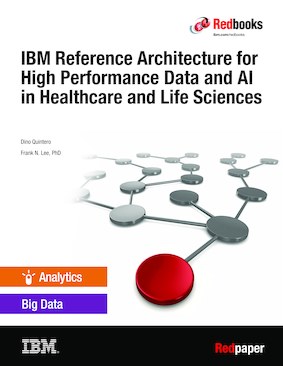About cookies on this site Our websites require some cookies to function properly (required). In addition, other cookies may be used with your consent to analyze site usage, improve the user experience and for advertising. For more information, please review your options. By visiting our website, you agree to our processing of information as described in IBM’sprivacy statement. To provide a smooth navigation, your cookie preferences will be shared across the IBM web domains listed here.

Published on 08 September 2019
Read in Google Books
Share this page:
ISBN-10: 073845690x
ISBN-13: 9780738456904
IBM Form #: REDP-5481-00
Authors: Dino Quintero, Frank N. Lee and PhD
Abstract
This IBM® Redpaper publication provides an update to the original description of IBM Reference Architecture for Genomics. This paper expands the reference architecture to cover all of the major vertical areas of healthcare and life sciences industries, such as genomics, imaging, and clinical and translational research.
The architecture was renamed IBM Reference Architecture for High Performance Data and AI in Healthcare and Life Sciences to reflect the fact that it incorporates key building blocks for high-performance computing (HPC) and software-defined storage, and that it supports an expanding infrastructure of leading industry partners, platforms, and frameworks.
The reference architecture defines a highly flexible, scalable, and cost-effective platform for accessing, managing, storing, sharing, integrating, and analyzing big data, which can be deployed on-premises, in the cloud, or as a hybrid of the two. IT organizations can use the reference architecture as a high-level guide for overcoming data management challenges and processing bottlenecks that are frequently encountered in personalized healthcare initiatives, and in compute-intensive and data-intensive biomedical workloads.
This reference architecture also provides a framework and context for modern healthcare and life sciences institutions to adopt cutting-edge technologies, such as cognitive life sciences solutions, machine learning and deep learning, Spark for analytics, and cloud computing. To illustrate these points, this paper includes case studies describing how clients and IBM Business Partners alike used the reference architecture in the deployments of demanding infrastructures for precision medicine.
This publication targets technical professionals (consultants, technical support staff, IT Architects, and IT Specialists) who are responsible for providing life sciences solutions and support.
Table of Contents
Chapter 1. Trends and challenges for precision medicine
Chapter 2. The journey of the reference architecture
Chapter 3. Deployment model
Chapter 4. Building blocks
Chapter 5. Use cases
Chapter 6. Case studies
Appendix A. Profiling GATK